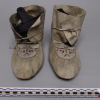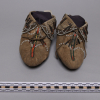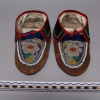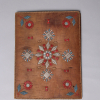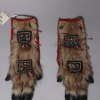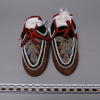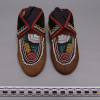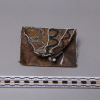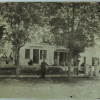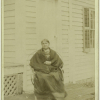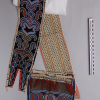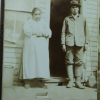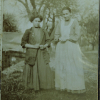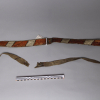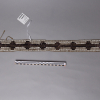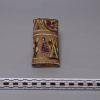Relatives/Heritage items
Displaying 1201 - 1220 of 4694 Relatives
Browsing allows you to see all the records for relatives and heritage items in the GKS. You can also search by material made, and/or filter by nations. To search by material made, type the material's name, by example 'leather', in the box below and click “Apply.” You can select multiple nations from the dropdown list by pressing “Ctrl” (on PC) or “Command” (on Mac) and clicking, then select “Apply.”
A pair of U-vamp, wrap-around moccasins decorated with porcupine quills. Made between 1830-1850, attributed to the Metis. Acquired by the museum through an exchange with the Christy Collection in 1869.
A pair of moccasins with central seam made between 1800-1850, attributed to the Hodenosaunee. Decorated with porcupine quills, glass beads, and metal cones with dyed animal hair. Transferred to Museum Volkenkunde from the Koninklijk Kabinet van Zeldzaamheden (The Royal Cabinet of Curiosities) in The Hague
A pair of Hodenosaunee moccasins with cuffs and ribbon ties, made ca. 1880. Blue cloth vamps decorated with raised floral beadwork. Purchased from collector Herman ten Kate in 1889.
An Anishinaabe birchbark letters folder with separate front and back cover, decorated with dyed porcupine quills in floral and geometric motifs, made in the 1880s. Gifted to the museum by Professor M. J. de Goeje in 1901.
This pair of Huron-Wendat wall pockets is each made of a moose foot and hoof with possibly blackened hide flaps, decorated with four panels (two per wall pocket) decorated with moose hair embroidery in floral motifs, metal cones, fringes of dyed animal hair, and glass
A pair of Hodenosaunee moccasins with cuffs and ribbon ties, made ca. 1880. Velveteen(?) vamps decorated with raised floral beadwork. Purchased from collector Herman ten Kate in 1883.
A pair of Hodenosaunee moccasins made in the 1870s. Velvet vamps and cuffs decorated with raised floral beadwork and zigzag lines. Purchased from Eckert in 1882.
Rectangular shaped animal skin pouch decorated with beadwork and coiled metal wire with small chain. Attributed to Hodenosaunee, made between 1850-1870. Purchased by the museum from L. Yvan in 1885.
Photograph of the home of Seneca Chief John Mount Pleasant on the Tuscarora Reservation. Taken in 1888 by J. W. Sanborn, a pastor of the First Methodist Episcopal Church in Lockport, New York. Donated to the museum by the anthropologist Herman ten Kate who, according
Photograph of the home of Mrs. Mount Pleasant on the Tuscarora Reservation. Taken in 1888 by J. W. Sanborn, a pastor of the First Methodist Episcopal Church in Lockport, New York. Sanborn gave the photograph to the anthropologist Herman ten Kate in March 1889 who
Portrait of Mrs. Chief John Mount Pleasant, born Caroline Parker, Hodenosaunee and member of the Tonawanda Seneca, sitting in front of her home on the Tuscarora Reservation. Photograph taken in March 1889 by J. W. Sanborn, a pastor of the First Methodist Episcopal Church in
A bandolier bag with tabbed strap, ornamented with beadwork, yarn tassels and silk ribbon work appliqué. Attributed to the Delaware, made between 1840-1870. Transferred to the museum from the Koninklijk Kabinet van Zeldzaamheden (The Royal Cabinet of Curiosities) in The Hague when it closed in
A portrait of two Seneca women, members of Mrs. Mount Pleasant's family, standing in front of a house on the Tuscarora Reservation. One of the women is probably Miss Lay. Photograph taken in 1888 by J. W. Sanborn, a pastor of the First Methodist Episcopal
Photograph of a house on the grounds of Mrs. Mount Pleasant's farm on the Tuscarora Reservation. Taken in 1888 by J. W. Sanborn, a pastor of the First Methodist Episcopal Church in Lockport, New York. Sanborn gave the photograph to the anthropologist Herman ten Kate
Portrait of Minnie Green and Warren Jack Daniel, Hodenosaunee. Taken by Mrs. W. M. Uhlenbeck-Melchior, the wife of the Dutch anthropologist and linguist, Dr C C Uhlenbeck, on the Tuscarora Reservation, New York between 1910-1911.
Portrait of Leah and Edna Patterson, Hodenosaunee. Taken by Mrs. W. M. Uhlenbeck-Melchior, the wife of the Dutch anthropologist and linguist Dr C C Uhlenbeck, on the Tuscarora Reservation, New York between 1910-1911.
A hide belt decorated with rows of wrapped quillwork and a small central vertical band of quills and glass beads. Purchased by the museum in 1883 from Charles Jamrach, a German arts dealer based in London who had an ethnography shop.
A belt of wampum shell beads with hide warps and possibly vegetable fibre wefts, woven into eight purple hexagonal motifs linked by a purple horizontal band against a white ground. Purchased from D. Cutter in 1883.
A birchbark pin cushion with silk ribbon sides and porcupine quillwork decoration in leaf and floral motifs, made between 1850-1900. Purchased from E. Horloos in 1894.
A Huron-Wendat birchbark cigar box or case decorated with moosehair embroidery depicting floral motifs and possibly gathering and cooking scenes, made between 1875-1900. Gifted to the museum by the widow of Johannes Bruining-Lindo in 1948.
 Knowledge Sharing Platform
Knowledge Sharing Platform

